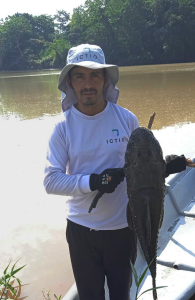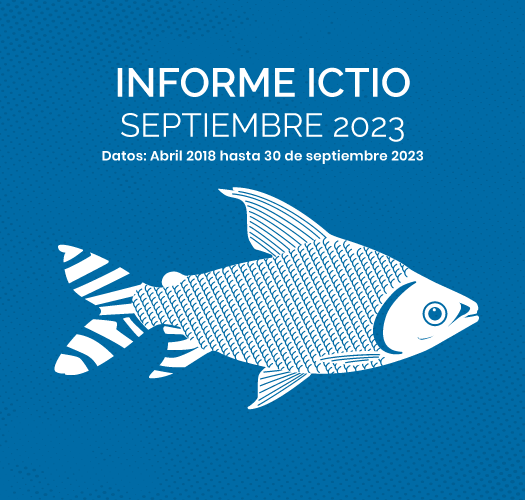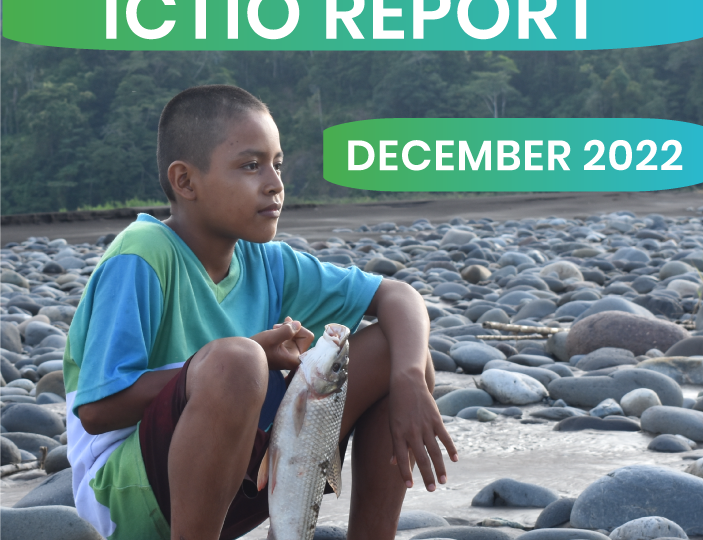Researchers and artisanal fishermen documented the species Acanthicus hystrix in the Napo River basin through the Ictio platform
A new research study reveals the presence of the catfish species Acanthicus hystrix in the Napo River in the Ecuadorian Amazon. Members of the Rio Napo Artisanal Fishermen Association, along with Kelly Tanguila, a student at the Amazon State University, in collaboration with Fernando Anaguano, a biologist from WCS Ecuador, made this discovery.
The research team photographed and captured a specimen, which confirmed the presence of this fish in the Napo River. As a result, it was possible to include, for the first time, a specimen of this species in the scientific collection of the museum of the National Institute of Biodiversity of Ecuador.
Three examples of this discovery were found along the Napo River, in Ballesteros, at the confluence of the Payamino and Napo Rivers, and at the confluence of the Jivino and Napo Rivers during 2022 and 2023. This research was published in the Neotropical Hydrobiology and Aquatic Conservation journal.
The first discovery of this species was made by Kelly Tanguila, co-author of the research, in April 2022, thanks to a fisherman who caught a specimen in Ballesteros, Orellana province. She photographed the fish and uploaded it to the Ictio citizen science database. This finding constitutes the first public record of the species A. hystrix in the Napo basin and, the second record for the Ecuadorian Amazon.
The fishermen of the Napo River Association made two more discoveries. One near the city of Coca in December 2022 at the confluence of the Payamino and Napo Rivers, and another in January 2023 at the confluence of the Jivino and Napo Rivers. On this last occasion, the fishermen of the association collected the fish, which was the first specimen of the species to become part of a scientific collection in the country.
Citizen Science in Action
The identification process of the specimens was based on in-situ photographs uploaded to the Ictio platform through its mobile application. In this manner, citizens helped the researchers to report the presence of the A. hystrix species in other areas of the Amazon and “expand the known species distribution range in the Ecuadorian Amazon,” meaning to broaden the geographical locations where the species lives and where it can be located.

“Beyond reporting on the presence of the species, we have demonstrated that researchers can rely on citizen scientists to report new information about certain species or their biology. Sometimes researchers want to do all the work, and that is practically impossible because we can only go to certain study areas for limited time, while fishermen are in their zones 365 days a year and know perfectly the fish species that are there. By working hand in hand with the fishermen who are generating key data, scientists can have a basis for their research,” says Fernando Anaguano, author of the study and fisheries specialist at WCS Ecuador.
The team who investigated the species was formed as a result of the training on the use of the Ictio application that WCS Ecuador gave to members of the Association of Artisanal Fishermen of the Napo River and university students in the Amazon.
“I knew that recently, two colleagues had published the record of the species A. hystrix in the Ecuadorian Amazon, and I was convinced that this species could be in the Napo basin. That’s why I asked the fishermen of the Napo River association and also the student to be aware of their catches to see if they could register this species in that area,” said Fernando Anaguano.
The Amazon Basin is a vast and interconnected region through its rivers, so studying its species and dynamics requires a collective scientific effort. Jonathan, Paola, Jonny, and Kelly are part of a network of more than 690 citizen scientists in the Amazon Basin. Their observations, recorded on the Ictio platform, contribute to a regional fish database that already has over 107,386 observations as of June 2023. Doing citizen science in the Amazon is a challenge, but artisanal fishermen and research teams demonstrate the great potential of citizen science and Ictio to feed the base of future discoveries.
For more information about this citizen science tool, visit ictio.org.






